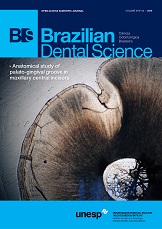The effect of propolis solution on root surface treatment in replanted teeth
DOI:
https://doi.org/10.14295/bds.2015.v18i3.1147Abstract
Objective: The objective of this study was to assess the effect of propolis solution on root surface treatment in cases of delayed tooth replantation following chemical or mechanical removal of the periodontal ligament. Material and methods: Maxillary right central incisors of 36 male rats (Wistar) were extracted, kept in a dry environment for 15 minutes and then distributed into six groups, as follows: mechanical-propolis and mechanical-fluoride (mechanical removal followed by immersion in 6% propolis and 2% sodium fluoride, respectively), mechanical (mechanical removal only), chemical-propolis and chemical-fluoride (chemical removal followed byimmersion in 6% propolis and 2% sodium fluoride, respectively), and chemical (chemical removal only). Following periodontal ligament removal, root canals were filled with calcium hydroxide paste and replanted. After 60 days, histological analysis with light microscopy was carried out to detect areas of dentoalveolar ankylosis and root resorption. Results: Results revealed that chemical removal of the periodontal ligament was associated with slightly better tissue repair findings when compared with mechanical removal. Conclusions: The use of 6% propolis solution encouraged tissue repair, while the 2% sodium fluoride solution combined with chemical removal resulted in a better-organized healing process, with less destruction of dentine when compared with the 6% propolis solution.Downloads
Downloads
Published
How to Cite
Issue
Section
License
Brazilian Dental Science uses the Creative Commons (CC-BY 4.0) license, thus preserving the integrity of articles in an open access environment. The journal allows the author to retain publishing rights without restrictions.
=================




























